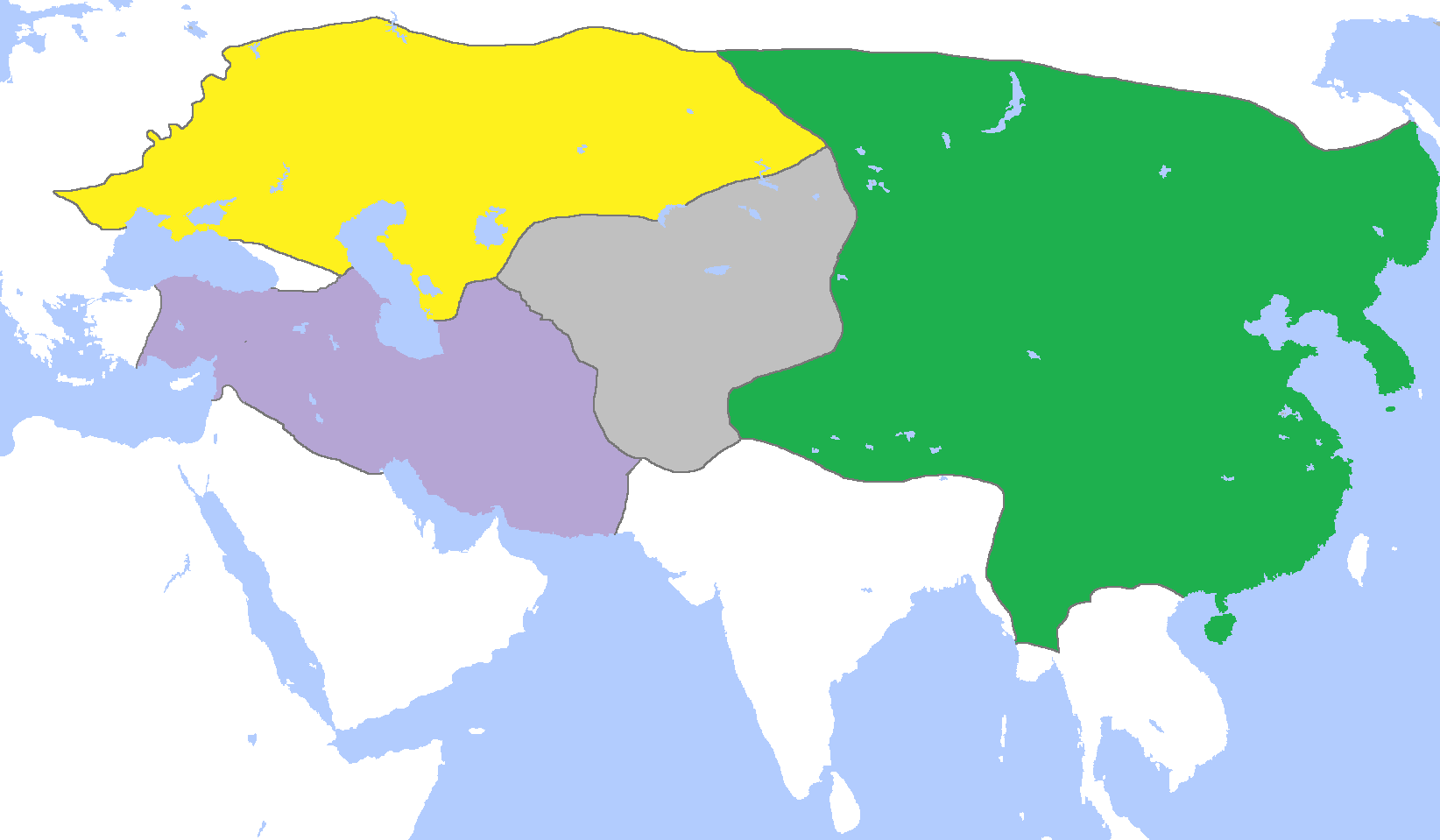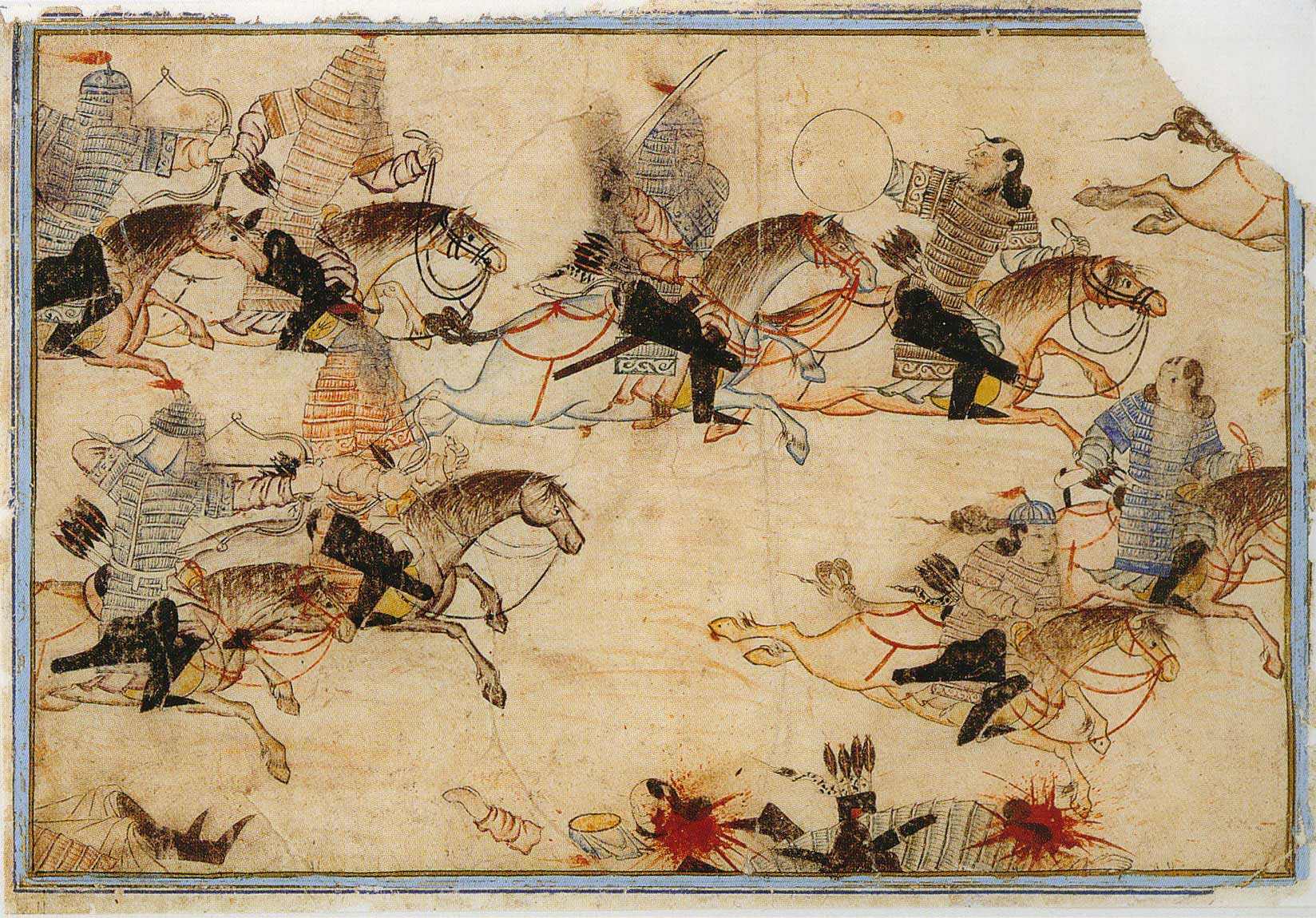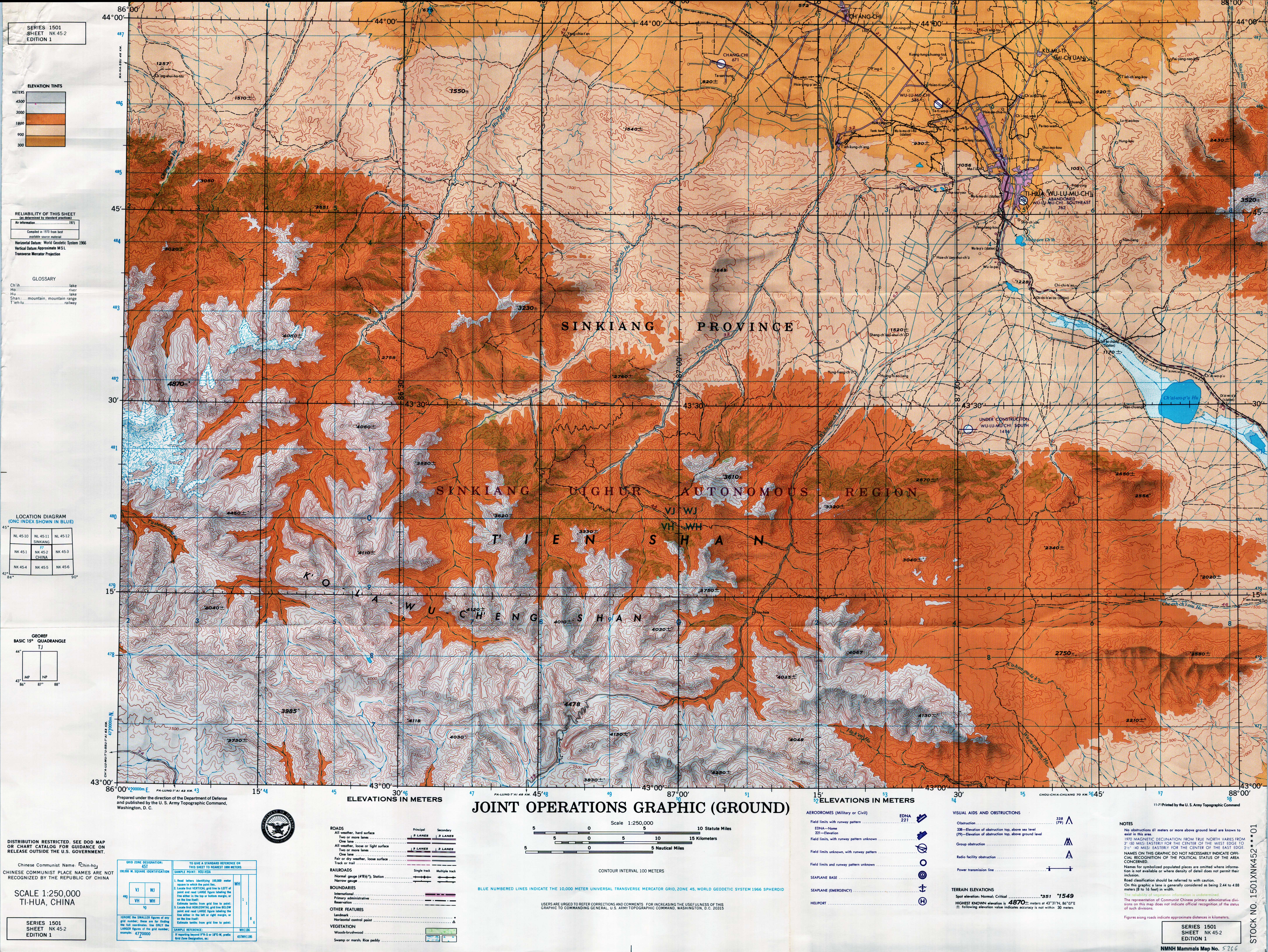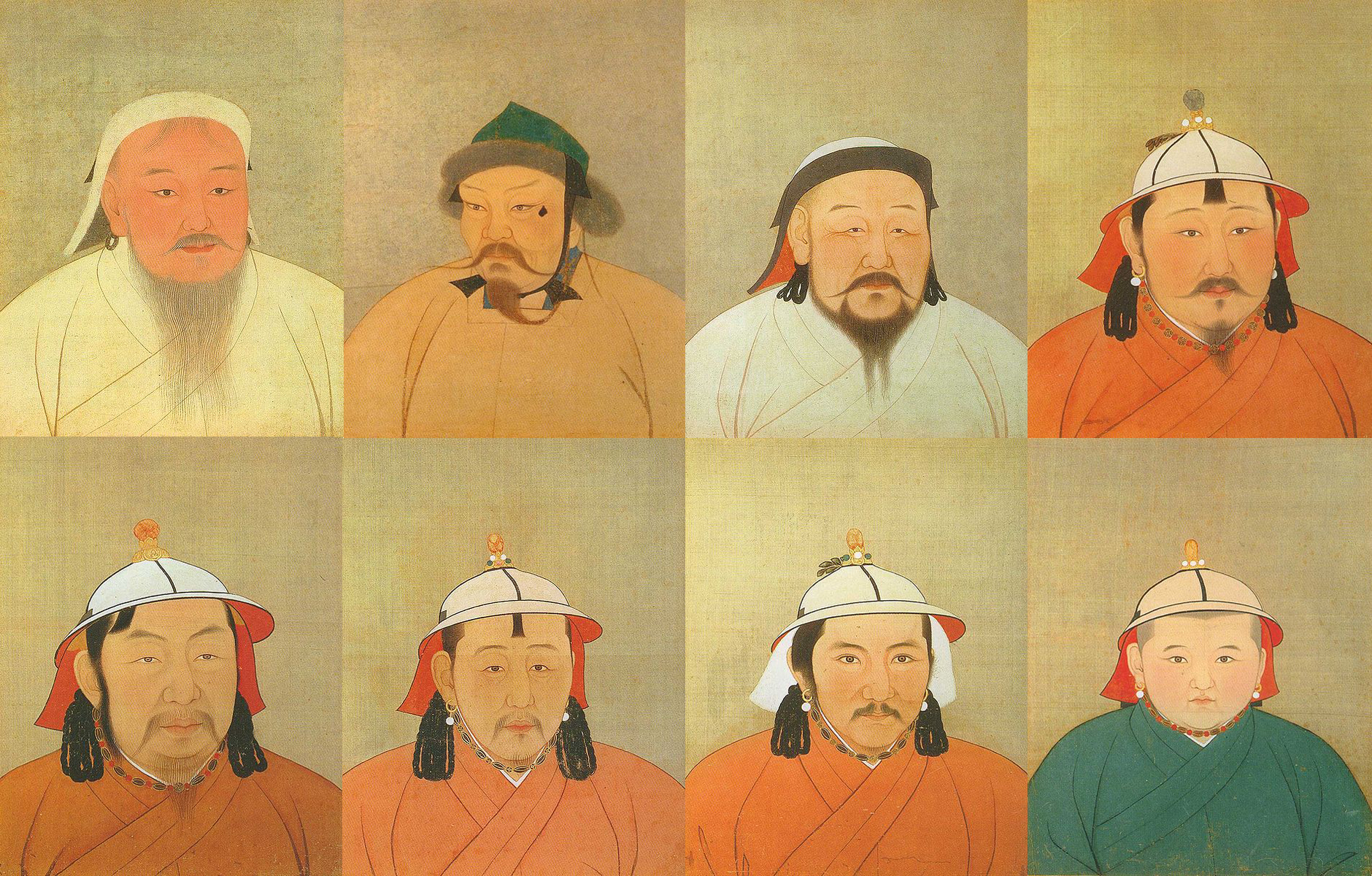|
Kaidu–Kublai War
Kaidu, the leader of the Mongol House of Ögedei, fought a war against Kublai Khan and his successor Temür from 1268 to 1301. Kaidu was the de facto khan of the Chagatai Khanate, while Kublai was the founder of the Yuan dynasty. The Kaidu–Kublai war followed the Toluid Civil War (1260–1264) and resulted in the permanent division of the Mongol Empire. By the time of Kublai's death in 1294, the Mongol Empire had fractured into four separate polities: the Golden Horde khanate in the northwest, the Chagatai Khanate in the middle, the Ilkhanate in the southwest, and the Yuan dynasty in the east based in modern-day Beijing. Although Temür later made peace with the three western khanates in 1304 after Kaidu's death, the four successor states of the Mongol Empire continued their own separate development and fell at different times. History Chagatai–Ilkhanid war After the Toluid Civil War, Kublai Khan summoned Kaidu at his court, but Kaidu avoided appearing at his court, ... [...More Info...] [...Related Items...] OR: [Wikipedia] [Google] [Baidu] [Amazon] |
Division Of The Mongol Empire
The division of the Mongol Empire began after Möngke Khan died in 1259 in the Siege of Diaoyucheng, siege of Diaoyu Castle with no declared successor, precipitating infighting between members of the Tolui family line for the title of khagan that escalated into the Toluid Civil War. This civil war, along with the Berke–Hulagu war and the subsequent Kaidu–Kublai war, greatly weakened the authority of the great khan over the entirety of the Mongol Empire, and the empire fractured into four khanates: the Golden Horde in Eastern Europe, the Chagatai Khanate in Central Asia, the Ilkhanate in Iran, and the Yuan dynasty in China based in modern-day Beijing – although the List of Yuan emperors, Yuan emperors held the nominal title of khagan of the empire. The four divisions each pursued their own interests and objectives and fell at different times. Most of the western khanates did not recognize Kublai as Great Khan. Although some of them still asked Kublai to confirm the enthron ... [...More Info...] [...Related Items...] OR: [Wikipedia] [Google] [Baidu] [Amazon] |
Toqta
Tokhta (also spelled Toqta, Toktu, Tokhtai, Tochtu or Tokhtogha; died ) was Khan of the Golden Horde from 1291 to 1312. He was a son of Mengu-Timur and a great-grandson of Batu Khan. His name "Tokhtokh" means "hold/holding" in the Mongolian language. Early reign under Nogai Nogai Khan orchestrated a palace coup that ended with the ousting of Talabuga and his execution. Tokhta became khan in 1291 and at first he was subordinate to Nogai. However, Tokhta eventually united his supporters against Nogai and he challenged Nogai's authority in 1297, leading to a civil war. In 1299, Nogai finally defeated Nogai and stabilized the Golden Horde. Tokhta wanted to eliminate the Russian princes' semi-independence and the Russian princes grew increasing restive. As a form of submission, military service was used by the khans, but Russian auxiliary troops were only used in rare attacks in Poland and Hungary, as well as in military campaigns in the Caucasus. Russian troops remained eff ... [...More Info...] [...Related Items...] OR: [Wikipedia] [Google] [Baidu] [Amazon] |
Ürümqi
Ürümqi, , is the capital of the Xinjiang, Xinjiang Uyghur Autonomous Region in Northwestern China. With a census population of 4 million in 2020, Ürümqi is the second-largest city in China's northwestern interior after Xi'an, also the second-largest in Central Asia in terms of population, right after Kabul, Afghanistan. Ürümqi has seen significant economic development since the 1990s and currently serves as a List of transport topics#Nodes, regional transport node and a cultural, political and commercial center. Etymology The name Ürümqi comes from the Mongolic languages, Mongolic Oirat language and means "beautiful pasture" (, ). It was originally the name of a small town founded by the Mongolic peoples, Mongolic, Oirat-speaking Dzungar people, Dzungars. The Qing dynasty took Ürümqi by force in 1755, during Dzungar–Qing Wars, its conquest of the Dzungar Khanate. Qing forces expanded the town into a walled city from 1763 to 1767, and upon completing the expan ... [...More Info...] [...Related Items...] OR: [Wikipedia] [Google] [Baidu] [Amazon] |
Sarai (city)
Sarai ( Turki/ Kypchak and Persian: سرای; also transcribed as ''Saraj'' or ''Saray''; "mansion" or "court") was the name of possibly two cities near the lower Volga, that served successively as the effective capitals of the Cuman–Kipchak Confederation and the Golden Horde, a Turco-Mongol kingdom which ruled much of Northwestern Asia and Eastern Europe, from the 10th through the 14th century. There is considerable disagreement among scholars about the correspondence between specific archaeological sites. Old Sarai "Old Sarai" (سرای باتو, ''Sarāy-i Bātū''; or سرای برکه, ''Sarāy-i Barka'') was established by the Mongol ruler Batu Khan (1227-1255), as indicated by both occasional references to the "Sarai of Batu" ("Sarai Batu", ''Sarāy-i Bātū'') and an explicit statement of the Franciscan William of Rubruck, who visited Batu in 1253 or 1254, on his way to the court of the Great Khan Möngke at Qaraqorum. William's statement, "Sarai, the new tow ... [...More Info...] [...Related Items...] OR: [Wikipedia] [Google] [Baidu] [Amazon] |
Negübei
Negübei was Khan of the Chagatai Khanate (1271–1272?). He was the son of Sarban. In 1271 Negübei was appointed by Kaidu as head of the Chagatai Khanate. A year after his enthronement, however, he rebelled against his master, possibly in conjunction with the revolts launched by the sons of Alghu and Baraq. Kaidu responded by sending an army against Negübei, and the latter was forced to flee to the east. Soon afterward, he was killed and replaced by Buqa Temür Buqa Temür ( Chagatai and Persian: بوقا تیمور; Cyrillic Mongolian: , not to be confused with Tuka Timur, son of Djötchi, brother of Berke) was Khan of the Chagatai Khanate (1272?-1282). He was the son of Qadaqchi. Sometime around 12 .... References 1272 deaths Chagatai khans 13th-century monarchs in Asia Year of birth unknown {{Mongol-royal-stub ... [...More Info...] [...Related Items...] OR: [Wikipedia] [Google] [Baidu] [Amazon] |
Mubarak Shah (Chagatai Khan)
Mubarak Shah ( Chagatai and Persian: مبارک شاه) was Khan of the Chagatai Khanate (1252–1260; March–September 1266) he was the son and successor of Qara Hülegü. Biography He was the son of Qara Hülëgü (son of Mötüken) and Ergene Khatun (daughter of Toralji Küregen). He was the first Chagatai Khan to convert to Islam. Upon the death of his father in 1252, Mubarak Shah succeeded him as Chagatai Khan, with his mother Orghana acting as regent. In 1260, however, the Great Khan claimant Ariq Böke appointed Chagatai Khan's grandson Alghu, and by the following year Alghu had control over much of the Khanate. When Alghu revolted against Ariq Böke in 1262, Orghana supported him. After Alghu died in 1266, Ergene enthroned Mubarak Shah as head of the ''ulus'' again, without the permission of Kublai Khan, who was also proclaimed the Great Khan and defeated Ariq Böke 2 years after. Kublai Khan, however, supported Baraq, a great-grandson of Chagatai as his co-r ... [...More Info...] [...Related Items...] OR: [Wikipedia] [Google] [Baidu] [Amazon] |
Herat
Herāt (; Dari/Pashto: هرات) is an oasis city and the third-largest city in Afghanistan. In 2020, it had an estimated population of 574,276, and serves as the capital of Herat Province, situated south of the Paropamisus Mountains (''Selseleh-ye Safēd Kōh'') in the fertile valley of the Hari River in the western part of the country. An ancient civilization on the Silk Road between West Asia, Central Asia, and South Asia, it serves as a regional hub in the country's west. Herat dates back to Avestan times and was traditionally known for its wine. The city has a number of historic sites, including the Herat Citadel and the Musalla Complex. During the Middle Ages, Herat became one of the important cities of Khorasan, as it was known as the ''Pearl of Khorasan''. After its conquest by Tamerlane, the city became an important center of intellectual and artistic life in the Islamic world. Under the rule of Shah Rukh, the city served as the focal point of the Timurid Re ... [...More Info...] [...Related Items...] OR: [Wikipedia] [Google] [Baidu] [Amazon] |
Persia
Iran, officially the Islamic Republic of Iran (IRI) and also known as Persia, is a country in West Asia. It borders Iraq to the west, Turkey, Azerbaijan, and Armenia to the northwest, the Caspian Sea to the north, Turkmenistan to the northeast, Afghanistan to the east, Pakistan to the southeast, and the Gulf of Oman and the Persian Gulf to the south. With a Ethnicities in Iran, multi-ethnic population of over 92 million in an area of , Iran ranks 17th globally in both List of countries and dependencies by area, geographic size and List of countries and dependencies by population, population. It is the List of Asian countries by area, sixth-largest country entirely in Asia and one of the world's List of mountains in Iran, most mountainous countries. Officially an Islamic republic, Iran is divided into Regions of Iran, five regions with Provinces of Iran, 31 provinces. Tehran is the nation's Capital city, capital, List of cities in Iran by province, largest city and financial ... [...More Info...] [...Related Items...] OR: [Wikipedia] [Google] [Baidu] [Amazon] |
Bukhara
Bukhara ( ) is the List of cities in Uzbekistan, seventh-largest city in Uzbekistan by population, with 280,187 residents . It is the capital of Bukhara Region. People have inhabited the region around Bukhara for at least five millennia, and the city has existed for half that time. Located on the Silk Road, the city has long served as a center of trade, scholarship, culture, and religion. Bukhara served as the capital of the Khanate of Bukhara, Emirate of Bukhara and later Bukhara People’s Soviet Republic. It was the birthplace of the scholar Imam Bukhari. The city has been known as "Noble Bukhara" (''Bukhārā-ye sharīf''). Bukhara has about 140 architectural monuments. UNESCO has listed the historic center of Bukhara (which contains numerous mosques and madrasas) as a List of World Heritage Sites in Uzbekistan, World Heritage Site. Names The exact name of the city of Bukhara in ancient times is unknown. The whole Oasis of Bukhara, oasis was called Bukhara in ancient times, ... [...More Info...] [...Related Items...] OR: [Wikipedia] [Google] [Baidu] [Amazon] |
Great Khan
Khagan or Qaghan ( Middle Mongol:; or ''Khagan''; ) or zh, c=大汗, p=Dàhán; ''Khāqān'', alternatively spelled Kağan, Kagan, Khaghan, Kaghan, Khakan, Khakhan, Khaqan, Xagahn, Qaghan, Chagan, Қан, or Kha'an is a title of imperial rank in Turkic, Mongolic, and some other languages, equal to the status of emperor and someone who rules a khaganate (empire). The female equivalent is Khatun. It may also be translated as " Khan of Khans", equivalent to King of Kings. In Bulgarian, the title became known as ''Khan'', while in modern Turkic, the title became ''Khaan'' with the ''g'' sound becoming almost silent or non-existent; the ''ğ'' in modern Turkish ''Kağan'' is also silent. After the division of the Mongol Empire, monarchs of the Yuan dynasty and the Northern Yuan held the title of ''Khagan''. ''Kağan, Hakan'' and ''Kaan'', Turkish equivalents of the title are common Turkish names in Turkey. The common western rendering as Great Khan (or ''Grand Khan'') ... [...More Info...] [...Related Items...] OR: [Wikipedia] [Google] [Baidu] [Amazon] |
Beijing
Beijing, Chinese postal romanization, previously romanized as Peking, is the capital city of China. With more than 22 million residents, it is the world's List of national capitals by population, most populous national capital city as well as China's List of cities in China by population, second largest city by urban area after Shanghai. It is located in North China, Northern China, and is governed as a Direct-administered municipalities of China, municipality under the direct administration of the Government of the People's Republic of China, State Council with List of administrative divisions of Beijing, 16 urban, suburban, and rural districts.Figures based on 2006 statistics published in 2007 National Statistical Yearbook of China and available online at archive. Retrieved 21 April 2009. Beijing is mostly surrounded by Hebei Province and neighbors Tianjin to the southeast; together, the three divisions form the Jing-Jin-Ji, Jing-Jin-Ji cluster. Beijing is a global city and ... [...More Info...] [...Related Items...] OR: [Wikipedia] [Google] [Baidu] [Amazon] |







